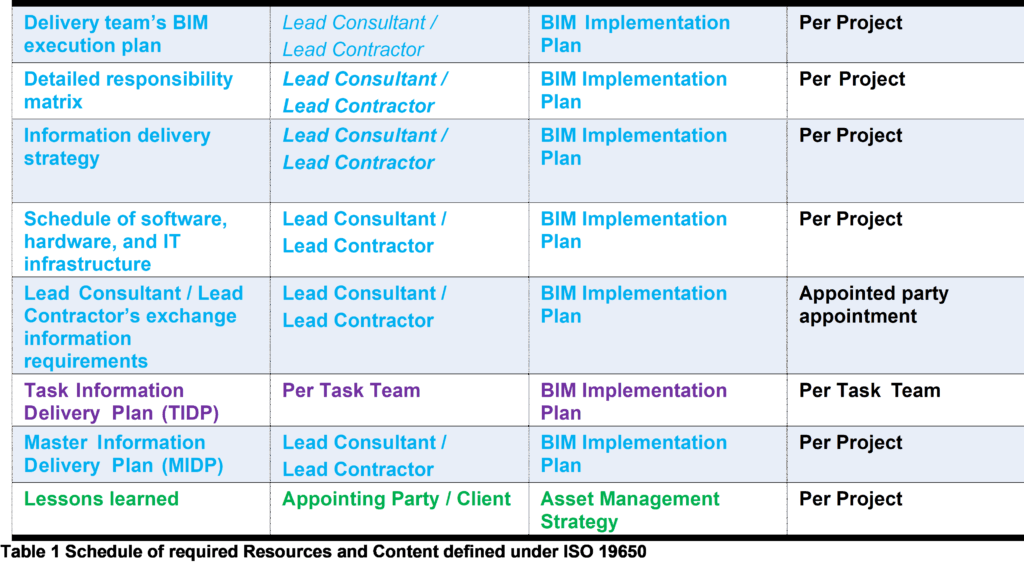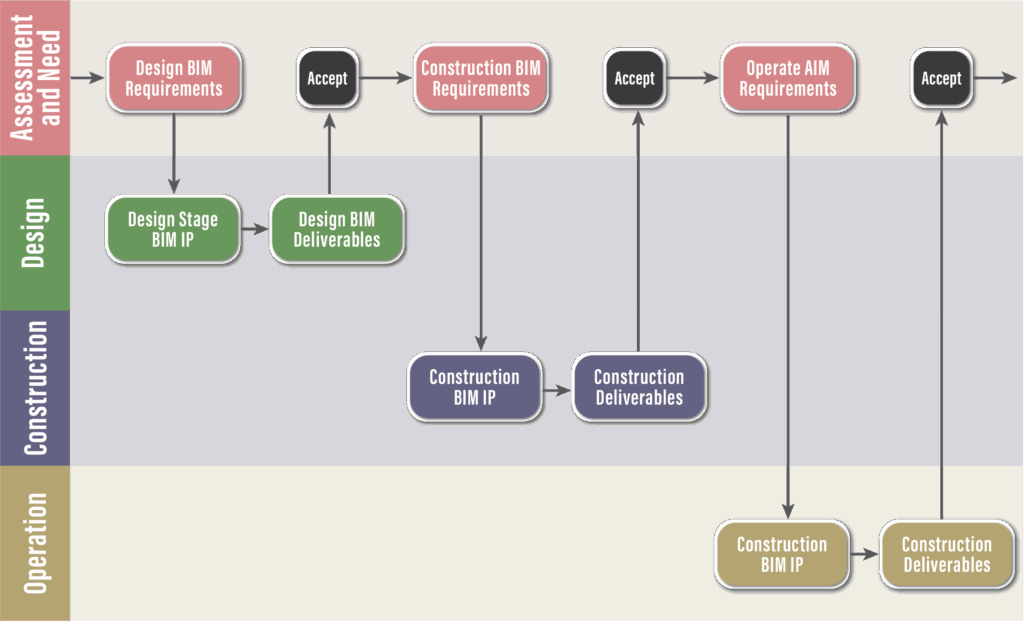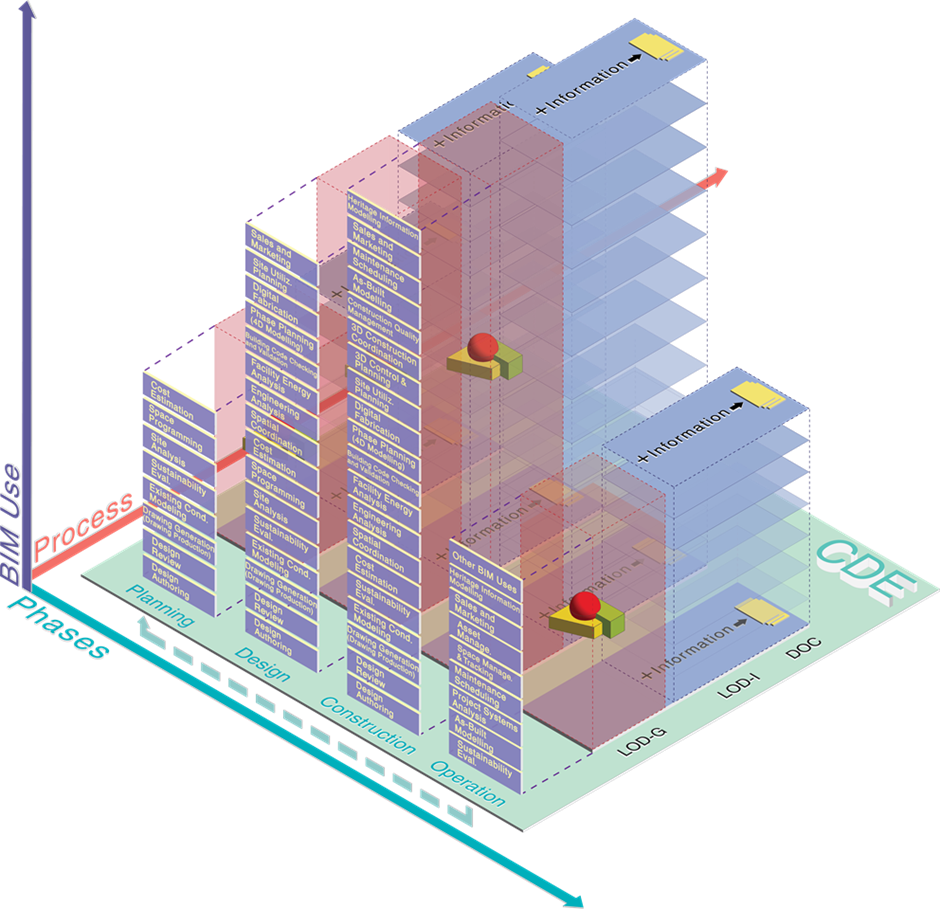Information Management using ISO 19650
The process of information management as identified in ISO 19650 requires the client to define their BIM information requirements prior to the appointment of a delivery team for either a design, construction, or operations project.
The concept is that these BIM requirements develop and modify throughout the life cycle with the information developed at each stage being used to enrich the requirements for the next project or project stage.
As well as the requirements being developed by the Client, shared resources should also be identified. These can include existing information about a site or built asset and can also include models and drawings of the asset or previous project stage undertaken. Therefore, the BIM deliverables produced at the Design Stage are provided as shared resources within the construction stage from which the constructor can develop their construction models.
Likewise, the construction models will be filtered to identify the asset information model which will be provided as part of the shared resources to facilitate the operations stage.
Therefore, if the project is procured as a Design / Build / Operate project the BIM requirements need to ensure that they are delivered in a manner to facilitate the different needs over the project lifecycle. In general practice, each activity of design, construction and operation are dealt with as separate projects. The completed BIM deliverables and BIM implementation plan from one project stage will be used to develop the BIM requirements for the next project stage.
It should also be noted that the requirements of ISO 19650 should be applied in a way that is proportionate and appropriate to the scale and complexity of the asset or project.
Standardisation of many of the requirements, templates and tools can facilitate the ease of use and aid in making the approach appropriate whilst achieving the recognised benefits.
i.
NOTE: No internationally agreed terms are defined for the collection of the Clients requirements or the collection of the responses from the delivery team.

The principles of ISO 19650 information management place the burden of responsibilities onto the Client to define what they want at each stage of the life cycle, “Starting with the end in mind”. Detailed explanation of each of the resource or content requirements is provided later within the guidance.
NOTE: The framework allows for the Clients to take on a third party to undertake these requirements on their behalf and this is the recognised approach where Clients do not have the appropriate resources.
Similarly, a designer or constructor as lead appointed party may also take on a third party to undertake their requirements where they do not have the appropriate resources.
Figure 5 Life cycle BIM Requirements and BIM IPs showing Client’s input

The following diagram summarises the BIM framework and Workflow:

Figure 6 Summary diagram of BIM framework and workflow
- Phases: Flow of information will flow from the Project Life Cycle: Planning, Design, Construction and Operation. The experience of BIM use in the Operation phase will form the requirement for the next project of the Organisation.
- BIM Use: Different BIM uses across different Phases.
- Process: For every BIM use, there is a process that involves Geometry (LOD-G), Information (LOD-I) and Documentation (DOC). (See 2.6 Level of Information Need
- Through the different phases, all the Information Exchange shall happen within controlled virtual environment – Common Data Environment (CDE)
Parties
An essential aspect of effective information management are clear definitions of ownership with identified responsibility and accountability. Information management functions provide an abstract hypothesis which translates to the need to identify the appropriate parties and responsibilities associated with each of the following project functions:
- Clients
- Clients’ delivery management function;
- Clients’ information management function;
- Asset information management function; and
- Security information management functions.
- Lead designer / lead constructor
- Project delivery management; and
- Project information management.
- Task team management functions
- Task management;
- Task information management;
- Interface management; and
- Information authoring.
Prior to the appointment of any parties, it is important to establish the capability and capacity of those undertaking these information management functions. Résumés, individual certification, and professional memberships are acceptable methods of reviewing capability. It should be noted that depending upon the size and complexity of a project functions can be handled differently. It should also be understood that information management responsibilities are likely to be only a part of the functional responsibilities that an individual will undertake on a project. For example, an individual may undertake the responsibilities of Project information management and task team information management whilst their predominant role is the project Architect, also undertaking lead designer responsibilities.
It is important to note that on a small simple project, it is likely that a single individual may take on multiple functions. On large complex projects, the opposite may apply where multiple individuals may be required to undertake a single information management function. Whichever is the case, these should be documented within the information management assignment matrix.
A clear definition of the tasks and those responsible should be identified in the information management assignment matrix provided by the Client as identified under Appendix B and this should then be expanded by the delivery team and managed through the project.
Project Information Management Functions
Th clients is required to assign their information management functions for them to ensure the BIM requirements are defined and delivered. The project information management functions should be assigned to the lead designer or constructor (Lead appointed party) for the specific project stage being undertaken. During the design stage, the functions should be undertaken by the lead designer and during the construction stage, the functions should be undertaken by the lead constructor.
The information management functions at the project level will break down into specific sets of functional criteria and these are:
Client information management functions;
- Client delivery management function
- Client information management function
- Asset information management function; and
- Security information management function.
Lead designer / constructor Functions:
- Project Information delivery management functions; and
- Project Information management functions.
Information delivery management deals with the project management tasks of ensuring that the right teams produce the correct information at the right time to meet the design and/or construction management requirements. It is important to recognise that information management is not a silo and needs to take on board design management and/or construction management needs depending upon the project stages being undertaken.
Client management functions
It is important to understand that the initial burden of information management lies with the Client to facilitate the process by defining their needs as the BIM requirements. It is recognised that few Clients have the appropriate knowledge or skill base to undertake this work and therefore, the process allows for a 3rd Party to undertake this work on behalf of the Client.
Where the Client will outsource this work, they should identify a clear scope of services for the function to be undertaken.
A clear definition of the tasks and those responsible should be identified in the information management assignment matrix provided by the Client as identified under Appendix B.
Clients’ delivery management function
The Client has a requirement to define their information management requirements, ensure that information is delivered in accordance with the information management requirements, and meet project milestones. There is also the obligation to accept information on behalf of the Client. These are identified as tasks to be assigned to a delivery management function.
This delivery management function is likely to be undertaken by those with job titles such as project manager, client’s agent, or their representative.
Clients’ security management function
It is important to understand that the initial burden of information security lies with the Client to undertake the security triage process and then if a risk is assessed appoint somebody to undertake the security functions on their behalf.
This function is likely to be undertaken by those with job titles such as quality manager or security officer.
Clients’ asset management function
The Clients has a requirement to define their asset information requirements and ensure delivery against this. This will identify an asset management function who will also identify what information is required from the project information model to populate the asset information model.
This function is likely to be undertaken by those with job titles such as operations manager or facilities manager.
Lead Designer / Construction Lead
Depending upon the project stage, the function of the ISO lead appointed party will be undertaken by either the lead designer or the lead constructor. They have specific duties to undertake and are responsible for:
- Task team(s) appointments and defining the information production responsibilities of each team;
- Defining the volume strategy and assigning the appropriate level of definition (volume module);
- Developing and gaining consensus of the project standards, methods and procedures (SMPs);
- Responding to the client’s information requirements within the BIM implementation plan; and
- Documenting and validating the information requirements within the Lead Designer / Constructors EIR(s).
- Reviewing the project information model against the clients information requirements and authorizing its contractual delivery on behalf of the delivery team.
This function is likely to be undertaken by those with job titles such as lead architect or lead engineer.
Project Information delivery management function
Within the lead designer / constructor, there are specific delivery management tasks associated with information management as well as the traditional design and construction management tasks. The information delivery duties to be undertaken may include:
- Compiling and managing the Master Information Delivery Plan (MIDP) from the task teams Task Information Delivery Plan (TIDP);
- Assessing the task team’s capacity to deliver information in accordance with the MIDP;
- Assuring the project information model is delivered in accordance with the MIDP;
- Managing risks associated with the delivery of the project information model; and
- Ensuring effective communication between the client, lead consultant/lead constructor, and each of the task teams.
This function is likely to be undertaken by those with job titles such as project manager or delivery manager.
Project Information management function
Within the lead designer / constructor, there are specific information management tasks as well as the information delivery tasks. The information management duties to be undertaken may include:
- Assessing the task team’s capability to produce information in accordance with the standards, methods, and procedures;
- Ensuring the availability of the Common Data Environment to all task teams;
- Assuring the project information model produced is in accordance with the project standards, methods, and procedures.
- Managing risks associated with the production of the project information model; and
- Reviewing and authorizing the project information model on behalf of the lead designer / constructor
This function is likely to be undertaken by those with job titles such as BIM manager or design manager.
Task Information management functions
Task teams are responsible for ensuring that information is delivered accurately and on time to meet project programs and requirements. The information management function breakdown for each task team can be generally described as
- Team management;
- Information management;
- Interface management; and
- Information authoring.
Task team management
The task team management function is responsible for the task team delivery and there are specific management tasks that need to be assigned or to be undertaken including:
- Task IM role appointments;
- Developing the Task Information Delivery Plan (TIDP);
- Ensuring the availability and capacity of competent resources to execute it;
- Approving the information produced by the task team against the task brief;
- Assigning the appropriate status (suitability) of the information shared by the task team; and
- Identifying and escalating risks associated with the delivery of the project Information model.
This function is likely to be undertaken by those with job titles such as architect or engineer.
Information Management
Associated with each task team is the delivery of information to meet project needs. Each Task Team will require information management functions which may include:
- Assuring (pass/fail) that the information produced by the task team is compliant with the project standards, methods, and procedures; (before being shared);
- Providing education and support to information authors with respect to the project standards, methods, and procedures; and
- Identifying and escalating risks associated with the production of the project information model.
This function is likely to be undertaken by those with job titles such as BIM coordinator or document controller.
Interface Management
Associated with each Task Team is the spatial coordination of information with other task teams. Each task team will require interface management functions which may include:
- Resolving spatial coordination issues with other task team interface functions;
- Escalating unresolved coordination issues to the design/construction lead; and
- Keeping the task team updated with agreed resolutions and progress of ongoing resolutions.
This function is likely to be undertaken by those with job titles such as BIM coordinator, architect, or engineer.
Information Authoring
The key function of each Task Team is the production of information. The main information management functions are the responsibility of those authoring information whose information managements functions may include:
- Creating files and ensuring the appropriate file attributes are captured correctly;
- Producing and/or amending information in accordance with the BIM Requirements;
- Producing and/or amending information in accordance with the Project IP;
- Ensuring graphical models (they produce) are spatially coordinated (clash avoidance) and escalating any interface issues to the Interface Manager;
- Ensuring all elements of the Information Model are fully coordinated with each other (graphical, non-graphical and documentation); and
- Checking submitted information prior to review and approval in accordance with the TIDP.
This function is likely to be undertaken by all those working within a Task Team.
Information Management Process
The Information Management process outlined in Appendix B Information Management Assignment Matrix identifies each of the information management functions associated with each party. For every project, each party is required to identify within an information management assignment matrix who will undertake the function on behalf of that party. This provides clear ownership and responsibility against each function.
Examples of how this can be applied to projects are found in 3.0 BIM Implementation Planning.